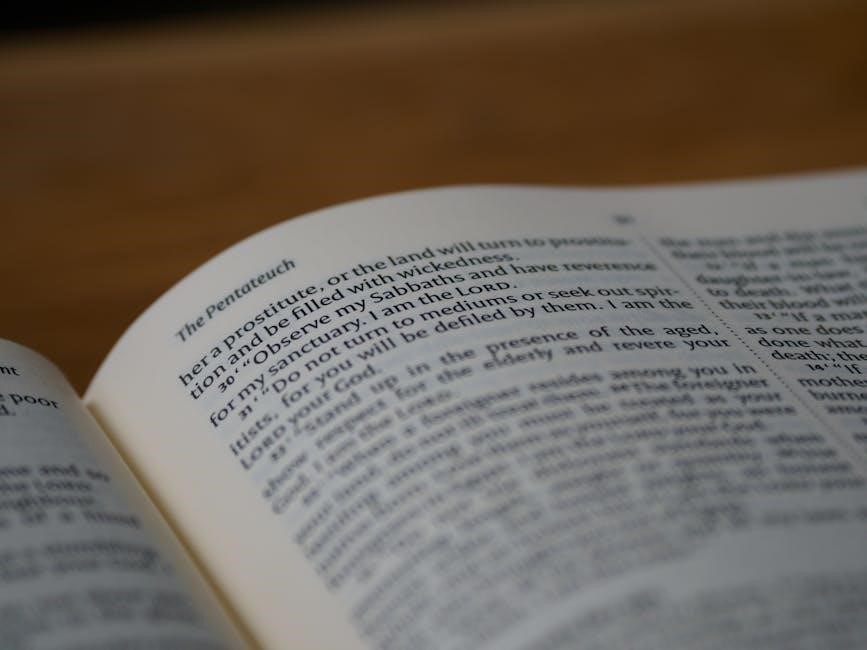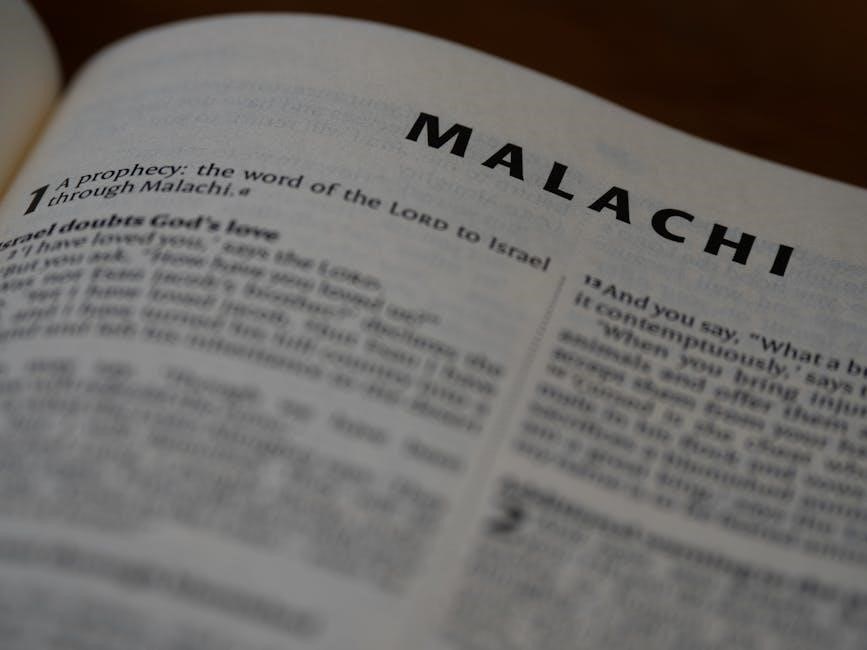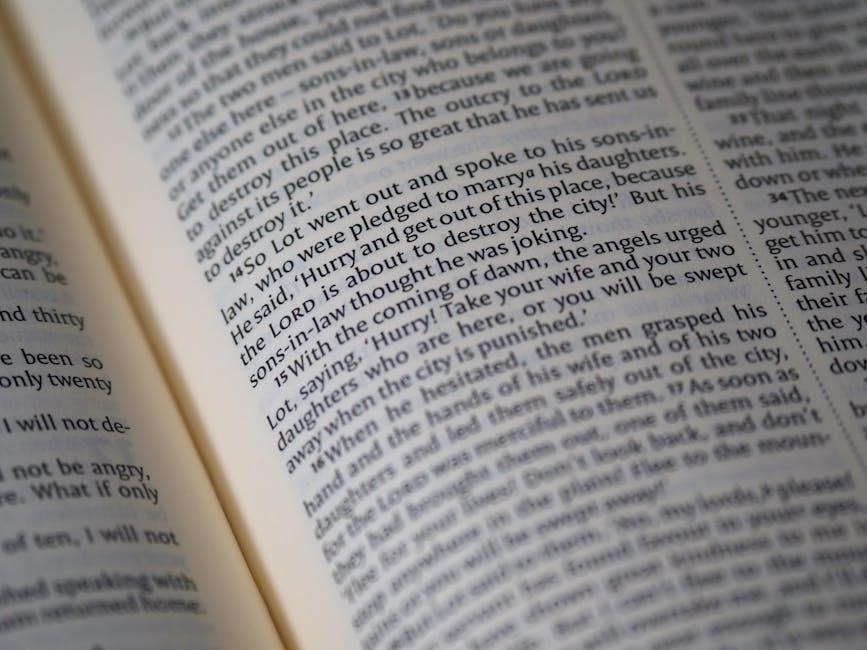A Bible reading plan combining the Old and New Testaments offers a structured approach to daily reading, fostering spiritual growth and a deeper connection with God’s Word.
What is a Bible Reading Plan?
A Bible reading plan is a structured guide that helps individuals systematically read through the Old and New Testaments over a set period, such as 260 days or one year. These plans often divide the Bible into manageable daily or weekly sections, ensuring a balanced approach to studying both testaments. They can be customized to fit various reading goals and schedules, providing a clear path for consistent engagement with Scripture.
The Importance of Reading Both Testaments
Reading both the Old and New Testaments provides a comprehensive understanding of God’s plan, revealing how the Old Testament sets the stage for the New Testament’s fulfillment. The Old Testament offers historical and cultural context, while the New Testament reveals Jesus Christ as the ultimate fulfillment of God’s promises. Together, they present a unified story of redemption, enriching spiritual growth and deepening faith.

Benefits of Using a Structured Bible Reading Plan
A structured plan ensures organized and consistent reading, helping users cover both Old and New Testaments thoroughly while staying on track with daily and weekly goals.
Spiritual Growth Through Daily Reading
Daily reading fosters spiritual growth by deepening understanding of God’s Word and its application in life. Consistent engagement with both testaments reveals their interconnected truths, strengthening faith and transforming hearts. Regular reflection on Scripture cultivates a deeper relationship with God, providing guidance and inspiration for daily living while fostering a lifelong commitment to spiritual development and discipleship.
Understanding the Connection Between Old and New Testaments
Understanding the connection between the Old and New Testaments is crucial for a unified grasp of Scripture. Reading plans that cover both testaments reveal how the New Testament fulfills the Old, showing Jesus as the climax of God’s plan. This approach provides deeper insights, helps trace recurring themes, and enriches the reading experience, fostering a clearer understanding of God’s redemptive story.

Structure of a Typical Bible Reading Plan
A typical plan spans 52 weeks, with daily readings from both the Old and New Testaments, dividing the Bible into manageable sections for consistent study.
Weekly and Daily Breakdowns
Most plans organize readings into weekly and daily segments, such as 5 days per week, with specific Old and New Testament passages assigned each day. For example, a 52-week plan divides the Bible into manageable portions, ensuring gradual progression. Weekly breakdowns often group related chapters or themes, while daily readings provide focused study. This structured approach helps maintain consistency and ensures completion of the Bible in a year.
Dividing the Bible into Manageable Sections
Reading plans often divide the Bible into daily or weekly sections, making it easier to track progress. For example, a 260-day plan focuses on key chapters, while a one-year plan covers the entire Bible. These sections ensure balanced coverage of both testaments, helping readers stay engaged without feeling overwhelmed. This approach makes daily reading achievable and sustainable.

How to Choose the Right Reading Plan
Selecting a plan depends on your goals, such as reading the entire Bible or focusing on specific sections. Choose a plan that aligns with your study preferences and schedule to ensure consistency and engagement.
Consider Your Reading Goals
Assess your spiritual objectives, such as reading the entire Bible, focusing on specific books, or exploring themes. Choose a plan that matches your goals, whether it’s a 52-week, 100-day, or 365-day schedule. Consider if you prefer a verse-by-verse study or a broader overview. Some plans balance Old and New Testament readings daily, while others focus on one section at a time. Aligning your plan with your goals ensures consistent progress and meaningful engagement.
Duration and Depth of Study
Bible reading plans vary in length, from 30-day New Testament focuses to 365-day comprehensive plans. Choose a duration that fits your commitment level, whether you prefer short, intense studies or longer, in-depth explorations. Some plans offer daily readings, while others provide flexibility. Consider if you want to cover the entire Bible or focus on specific sections, ensuring the plan aligns with your time and spiritual goals.

Popular Types of Bible Reading Plans
Plans include chronological, Old/New Testament combined, 30-day New Testament, 100-day complete Bible, and 365-day options, often available as printable PDFs for convenience.
Chronological Reading Plans
Chronological plans organize Bible reading according to historical events, blending Old and New Testament narratives. They follow the timeline of biblical history, helping readers understand the progression of God’s story. These plans often span 365 days, covering the entire Bible in order. Some focus on specific sections, like the New Testament in 30 days, while others provide a balanced approach. PDF formats are widely available, making it easy to track progress and stay organized.
Old and New Testament Combined Plans
Combined plans offer daily readings from both the Old and New Testaments, providing a balanced approach to understanding God’s Word. These plans often cover the entire Bible in 260 or 365 days, ensuring a comprehensive study. They include specific passages from both testaments each day, helping readers connect themes and see the unity of Scripture. PDF formats are widely available for easy download and printing.

Downloading a Bible Reading Plan PDF
Bible reading plans in PDF format are widely available for download, offering structured schedules for reading the Old and New Testaments. Many plans are free and can be found on official church websites or platforms like YouVersion or BibleGateway, providing printable and digital options for convenience.
Where to Find Free Resources
Free Bible reading plan PDFs are available on platforms like YouVersion, BibleGateway, and church websites. Many offer customizable plans, including Old and New Testament combinations. Websites like BibleGateway provide printable schedules, while apps like YouVersion offer digital downloads. Additionally, some ministries offer downloadable PDFs for specific reading goals, such as 260-day or 100-day plans, ensuring accessibility for all readers.
Printable and Digital Formats
Bible reading plans are available in both printable and digital formats, catering to different preferences. Printable PDFs allow for physical tracking with checkmarks, while digital versions offer convenience through apps and online platforms. Many plans come in customizable sizes, ensuring readability and ease of use. This versatility makes it simple to integrate Bible reading into daily routines, whether at home or on the go.

Customizing Your Reading Plan
Customizing your Bible reading plan allows you to tailor schedules, incorporate study guides, and use digital tools for a flexible and deeply personalized experience.
Adjusting the Schedule to Fit Your Lifestyle
Flexible Bible reading plans allow you to adjust schedules to suit your daily routine, ensuring consistency and making it easier to stay committed. Whether you prefer a 52-week, 100-day, or 365-day plan, you can tailor the pace to match your lifestyle; Many plans offer printable and digital formats, enabling you to track progress and adapt as needed for a seamless reading experience.
Incorporating Study Guides and Devotionals
Enhance your Bible reading plan by incorporating study guides and devotionals for deeper insights. These resources provide contextual explanations, historical background, and practical applications, helping you connect biblical truths to everyday life. Many PDF plans include devotional reflections, making it easier to apply spiritual lessons and grow in faith consistently.

Staying Consistent with Your Reading Plan
Set reminders, use printable PDFs, and track progress to maintain consistency. These tools help you stay engaged and committed to your Bible reading journey daily.
Setting Reminders and Notifications
Setting daily reminders on your phone or calendar ensures consistency in your reading plan. Use digital apps or physical planners to stay on track. Many PDF plans include checkmarks or progress bars to visually track your journey. Consistency fosters habit, helping you engage deeply with both Testaments and reflect on their teachings regularly.
Tracking Progress and Reflection
Tracking your progress in a Bible reading plan helps maintain accountability and motivation. Many PDF plans include checkmarks or charts to monitor your journey. Reflecting on key verses or insights each day deepens spiritual understanding. Writing down thoughts or questions in a journal enhances engagement and fosters a meaningful connection with God’s Word throughout the year.

The Cultural and Historical Context
Old and New Testament Bible reading plans highlight the cultural and historical context, offering insights into ancient traditions and events that enrich and deepen your study.
Understanding the Background of Each Testament
Exploring the historical and cultural settings of the Old and New Testaments provides essential context for understanding their teachings. The Old Testament reveals God’s relationship with Israel, while the New Testament focuses on Jesus’ life and the early church. This background enriches your reading, helping you connect ancient stories to modern faith.
How Context Enhances Your Reading Experience
Understanding the cultural and historical context of the Old and New Testaments brings clarity to the text, making it more relatable and meaningful. Knowing the customs, events, and traditions behind the passages deepens your appreciation of God’s plan and connects the testaments, revealing a cohesive story of redemption and grace.

Combining Old and New Testament Readings
Combining Old and New Testament readings provides a balanced view of God’s plan, revealing connections and fulfilling prophecies, enriching your understanding of His unified story.
Parallel Reading for Deeper Insights
Parallel reading involves studying Old and New Testament passages side by side, revealing their interconnectedness. This approach highlights how prophecies, themes, and events in the Old Testament are fulfilled or reflected in the New Testament, offering a richer understanding of God’s plan and redemptive story. It encourages a holistic view of Scripture, deepening spiritual insight and appreciation for the Bible’s unity.
Seeing Jesus in the Old Testament
Discovering Jesus in the Old Testament enriches your understanding of His mission and identity. Through typology, prophecies, and shadows, the Old Testament points to Christ, such as in Genesis 3:15 and Psalm 22. Figures like Adam and Joseph serve as types of Christ, foreshadowing His role as the ultimate Savior. This connection deepens believers’ appreciation for the unity of Scripture and God’s redemptive plan.
Resources to Accompany Your Reading Plan
Enhance your Bible reading plan with study Bibles, commentaries, and online communities. These resources provide historical context, deeper insights, and practical tools for meaningful study.
Study Bibles and Commentaries
Study Bibles and commentaries are invaluable resources for enhancing your Bible reading plan. They provide historical context, explain complex passages, and offer insights into the cultural and theological significance of both the Old and New Testaments. Features like maps, timelines, and notes help deepen your understanding. These tools complement your reading plan by bridging the gap between ancient texts and modern application, enriching your study experience.
Online Communities and Apps
Online communities and Bible reading apps provide convenient tools to support your reading plan. Apps like YouVersion offer customizable plans, reminders, and progress tracking. Digital platforms also allow you to join groups for discussion and accountability. These resources make it easier to stay connected and engaged with your Old and New Testament readings, enhancing your spiritual journey through technology and community support.
Celebrate completing your Old and New Testament Bible reading plan, reflecting on spiritual growth. Embrace lifelong learning, inspired by God’s Word to deepen your faith journey daily.
Final Thoughts on Completing the Plan
Completing a Bible reading plan is a significant achievement, offering a sense of accomplishment and deeper spiritual understanding. Reflect on the journey through both testaments, celebrating the connection between Old Testament promises and New Testament fulfillment. The experience fosters growth, revealing Jesus as the centerpiece of Scripture. Embrace the transformative power of God’s Word and continue applying its truths in daily life.
Encouragement for Lifelong Bible Reading
Embrace Bible reading as a lifelong journey, not just a plan. Consistency nurtures spiritual growth, deepening your connection with God. By engaging both testaments, you gain a holistic view of His love and redemption. Celebrate progress, learn from challenges, and trust in the transformative power of Scripture to guide and inspire you daily.
